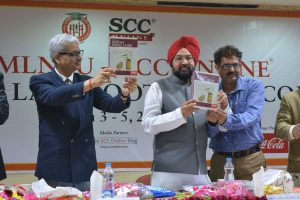Dr Pandey, when asked to comment on the release, informed the audience that apart from revision, he has also added chapters on Penology, Victimology, and Juvenile Justice System. He got nostalgic and told the audience about how he had first encountered Gandhi’s IPC in 1996 when he was a first year LLB student, and thereafter not only did he immensely enjoy the text but also had since dreamt of revising the book someday.
The current fourth edition of B.M. Gandhi’s Indian Penal Code revised by K.A. Pandey is an authoritative commentary on the subject. The revising author has thoroughly revised and updated this work incorporating the latest statutory and case law developments.
The following are the notable features of this new edition:
- Analyses the provisions of the Criminal Law (Amendment) Act, 2013.
- Aggravated forms of offences and their cognate offences have been grouped together for easy grasping.
- Contains recommendations of Law Commission of India and important committees .
- Contains relevant provisions of connected legislations to impart a complete knowledge. For example, criminal liability of a child has been discussed vis-à-vis the Juvenile Justice (Care and Protection of Children) Act, 2015.
- A new appendix on victimology and rights of victim has been added.
- Prominent cases and principles included in a Box.
- Overview at the start of each chapter prepares the reader to easily learn and conceptualise things discussed in the chapter.
REVIEWS
“The book can be claimed to be a rational combination of a text book and lawyer’s commentary and this feature has been rightly claimed as its novel feature … has merits of its own and deserves a place in all law libraries.” —Central India Law Quarterly
“… distinct from other books on the Code in that it briefly discusses the concept of socio-economic crimes with a historical outline of their origin and their nature and scope; it also mentions about the nexus between politics and crime and provides a statistical estimate of crimes likely to be committed in India of the 21st century.” —Cochin University Law Review
The book can be purchased here.
Additional resources to the book are available here on the EBC Explorer

